Graham Reid | | 7 min read
Autumn Moon Over Still Lake
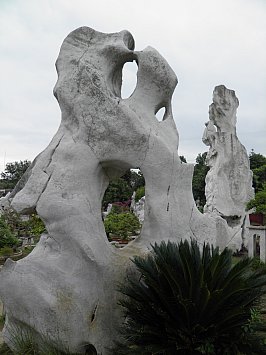
In Guizhou province they move mountains. Literally.
Here in this vast region of south west China – two thirds the area of New Zealand and with a population around 40 million – mountains are moved for motorways and housing, shaped into terraces for crops or highrise apartments, bored through for lengthy tunnels and have enormous bridges strung between them.
Beipanjiang Bridge which opened in 2010 spans the massive Malinghe Gorge and is the highest in Asia.
It cuts 40 winding kilometres off the old route and is spun like a steel spider's thread almost 400 metres above the valley.
The Maling River below is known as “the number one rafting” spot in the region.
“This is the bridge,” says my guide Paul who has an amusing habit of sometimes stating the obvious.
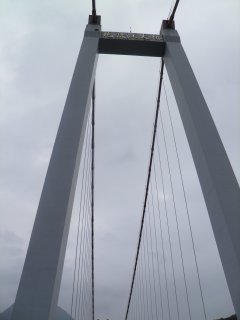 It is an exceptional piece of
engineering, but in this industrious region where construction – of
houses, roads, factories and whole towns – is endemic, even the
bridge is just another Very Big Thing and comes with that peculiar
lexicon of the Chinese.
It is an exceptional piece of
engineering, but in this industrious region where construction – of
houses, roads, factories and whole towns – is endemic, even the
bridge is just another Very Big Thing and comes with that peculiar
lexicon of the Chinese.
“It is China's number one bridge,” says Paul confidently.
Equally impressive is Huangguoshu Falls (Yellow Fruit Tree Falls) which is one of the biggest waterfalls in the world.
There's an open debate about the size of waterfalls. Do you measure width, height, volume of water . . . or what? But let's agree Huangguoshu Falls – 74 metres high, at least 80 metres wide – is among the big ones. It is also unique because you can see it from six angles: top and bottom, both sides, from in front . . . and from the back where a slippery 134 metre paved path behind the torrent lets you glimpse its thundering power through six cave windows.
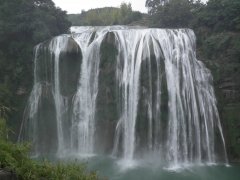
Then there are the spectacular mountains in Guizhou province, some of which were inconveniently placed so have been moved. But before anyone gets too precious about destroying mountains, let's concede Guizhou isn't short of them.
In fact, once outside a city like Guiyang – the provincial capital with a population around six million and named the Summer Resort Capital of China in 2006 – the landscape can be dramatic. The map is littered with the names of caves, waterfalls, rivers, gullies and gorges, lakes (like Wanfeng, one of the 10 largest in the country) and, of course, mountains.
(Although I never did remember to ask Paul about one name which leapt out at me, Xifeng Concentration Camp near Xifeng Hot Springs.)
“There are the mountains,” says Paul with all the authority of a man who has read about mountains so knows 'em when he sees 'em. And there are mountains by the hundred. Some jagged and precipitous, others worn smooth by eons. Most are unhindered by developers and mountain movers.
For such a seemingly populated region, away from the few cities the land is rural and punctuated by small villages and farms where women with babies on their backs strain behind an old wooden plough pulled by an ox.
If it weren't for the ubiquity of cellphones out here you could be looking at China of a century ago – but in the background a new motorway may be arcing across the sky.
This fascinating and often exceptionally photogenic province – closer to the autonomous region of Tibet than it is to Shanghai or Beijing – is home to 17 distinct ethnic minorities, most notably the often-visible Miao, many of whom live in their own autonomous prefecture in the south.
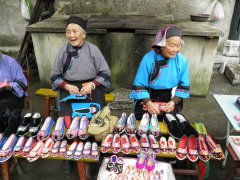
Around the dark wooden houses and narrow lanes of the village, bright red and green chili pods hang drying on old stone walls, yellow corn cobs are tied like bunches of bright bananas and strung from rooftops, and vendors in the alleys and small courtyards sell oily but delicious deep fried patties of onion or potato.
It is a mark of how immune many are to tourism that – despite a full costume welcome at the main gate – there's not much to buy in the village, unless your taste runs to old comics, tattered copies of Chairman Mao's Little Red Book, opera masks or tiny colourful shoes made by old women in the courtyard of a small temple. Aside from farming, the decorative arts appear to be the Miao speciality.
English is rarely spoken and some locals consider Europeans such a rare species they have their photo taken with them. Perhaps because they aren't jaded by regular doses of foreign visitors, the people are good humoured, friendly and the universal language of pointing, smiling and counting on fingers works well.
Everything in this province – food, beer, clothing and trinkets – is astonishingly cheap. You can go a long way on 100 yuan ($20), and you'd certainly never be hungry or thirsty.
Maotai, the local liquor made in the Guizhou town of the same name from fermented sorghum, is hard to refuse – indeed it would be a slight to your host to do so – but isn't quite so easy to enjoy. This “acquired taste” is considered China's “number one” drink and is used at formal receptions. Because it came from this region the people are proud of it and will produce a bottle (sometimes not cheap for them) by way of making you welcome. A tip however: avoid the local “red wine” for the sake of your tastebuds. Wine-making is a skill which has so far eluded these productive and busy people.
Mountainous Guizhou is a fascinating part of China and central government is pouring money into this region to attract tourists – which accounts for those wide motorways, bridges and tunnels. But it is still overwhelmingly domestic tourists who come to this often very beautiful region.
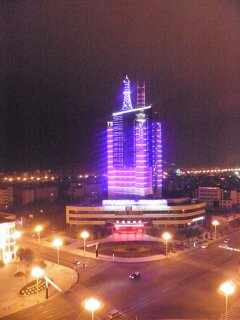 In that habit so beloved in China's
government for bugle-call slogans and projects, this strategy for
large-scale development, begun in 1999, is called “The Great West
Initiative” and the government is assisting “an accelerated
development of the western region . . . so as to narrow the gap
between the eastern and western regions”.
In that habit so beloved in China's
government for bugle-call slogans and projects, this strategy for
large-scale development, begun in 1999, is called “The Great West
Initiative” and the government is assisting “an accelerated
development of the western region . . . so as to narrow the gap
between the eastern and western regions”.
The key tasks are “to accelerate
infrastructure construction, to strengthen ecological and
environmental protection, to consolidate the basic position of
agriculture, adjust industrial structure and develop the tourist
industry with special characteristics . . .”
Jargon and words,
but the evidence is everywhere – although international visitors
might wonder just how much say locals have when it is decided the new
motorway will go straight through their village. Everywhere small and
large construction is in evidence. The convention centre opposite the
enormous and glitzy Hyatt Regency in Guiyang covers an area the size
of a New Zealand provincial town.
New highrise hotels, shopping complexes and complete towns are appearing in the landscape, most near the many scenic attractions.
Even so, last year fewer than 90,000 foreign tourists visited Huangguoshu Falls. At least so I was told, although someone else shook their head and said it would be more like 9000, which – even though confidently stated statistics can be flexible in China – seemed more probable.
And you can guess even fewer make it to the bizarre but fascinating Exotic Stones Exhibition Hall nearby where none of the signs are in English.
Here is an exceptional collection of fossils of lizards and fish from an unimaginably long time gone, enormous crystals, weirdly shaped rocks, stones which look like sculptures by Barbara Hepworth or Henry Moore . . .
The most striking exhibits – aside from a brutally phallic rock beside what looks like an obscene feminine sex object of the kind you might find in Amsterdam's red light district – are the massive fossils of prehistoric plants and animals unearthed in the area. There are dozens of them.
Some plant fronds and stalks stretch a metre or two. But the veins in leaves, like those in some of the prehistoric fish, are suspiciously exact. Paul wouldn't countenance they were anything but authentic, however it looked as if craftsmen had been at work with thin, sharp implements making sure these fossils were finely detailed.
Even so, I came away impressed by this newly-opened building full of strangely shaped crystals, rocks with what looked like images of people and animals within them . . . and especially those rude things. But the Chinese might need to suspend belief in the authenticity of some “fossils”, impressive though they are.
But no such skepticism was necessary at the aptly named Ten Thousand Peaks Scenic Spot near the city of Xingyi close to the southern border with Yunnan province, and a town which enjoys some of the newest and finest tree-lined motorways and boulevards imaginable.
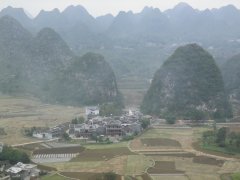
Paul tells me the people had been abandoning traditional farming and were moving to the cities, but the government encouraged them to stay by offering significant tax breaks. Quite significant.
“They pay zero percent,” says Paul flatly.
That is certainly an encouragement, but the beauty of the region must be attractive anyway. It is one of the most picturesque places in the province, if not the county.
In the distance between the smooth peaks rising like massive thimbles I can just discern a pagoda. It looks like a painting of the kind you sometimes see in the better galleries of traditional art in China.
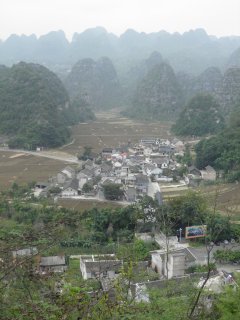 “This is the scenic spot”, says
Paul. And again, he cannot be contradicted.
“This is the scenic spot”, says
Paul. And again, he cannot be contradicted.
Below us a broad field has been ploughed in a traditional Taoist design. Wisps of smoke from late afternoon grass fires drift down the valley and curl softly around the sides of the mountains which disappear into infinity and the heat haze.
Then Paul says something genuinely interesting, in February and March these fields blaze with yellow canola flowers which carpet the whole floor of this vast valley.
Now that's something I would move a mountain to see.
For further information on tourism and general travel enquiries about China go to www.chinatravel.co.nz
For specific information on Kunming go to www.ynta.gov.cn

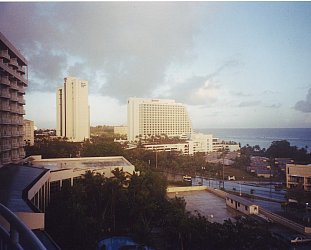



post a comment